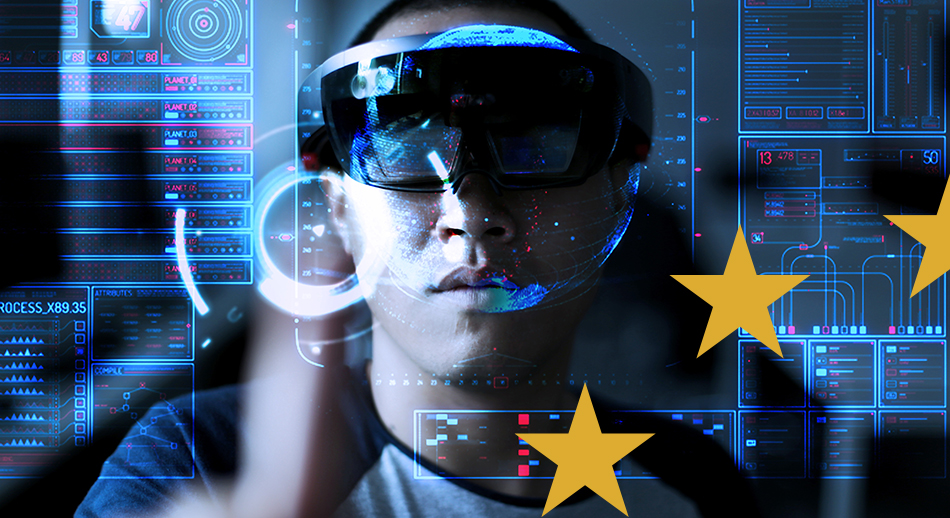Digital and new technologies are the focus of the EU, of European programs in this seven-year period and of important initiatives in our territories.
New digital technologies: a quick review
Digital and the potential of new technologies related to digital are at the center of the strategic interests of the European Union, represent one of the main areas of confrontation between world powers, and open up immense opportunities and potential for the development of territories.
Technical progress and applications in the digital sphere go through a process of continuous and dizzying evolution: it is therefore difficult to determine their nature and scope exhaustively. For the purpose of clarification, without claiming to be exhaustive and glossing over technical details, we can attempt to define some of the cutting-edge areas in which they intervene, and some of the terms that recur most frequently in digital-related strategies, programs and projects.
- Artificial Intelligence : Computer applications capable of autonomously carrying out processes of learning, understanding, deduction, prediction and problem solving;
- Big Data : management of advanced information systems to collect, organize, and exploit large masses of data (often “micro” in nature) for deeper or otherwise impossible analyses and predictions;
- Data centers : large infrastructures where large amounts of data, necessary for many modern and advanced digital applications, can be collected, organized, processed and disseminated;
- High Performance Computing (or High Performance Computing): use of high-performance, high-capacity data processing systems (or “supercomputers”) for analysis of the highest complexity;
- Cloud computing : use of centralized computing infrastructure capable of storing, processing and redistributing data from a large volume of users in an immediate manner;
- Edge computing : Use of computing infrastructure capable of storing and processing a significant amount of data quickly and decentralized, in close proximity to the user;
- Internet of Things : technologies that enable physical objects (connected to each other and to broader platforms) to collect and process data and interact with the environment and the user;
- Digital Twins: Digital representations of physical entities (living or nonliving) that can exchange data and information with their real counterparts, evolve and react accordingly;
- VR / AR : systems for simulating physical experiences through digital interfaces (virtual reality) or enriching physical perception through digital data (augmented reality);
- 5G e 6G : mobile telecommunication standards, technologies and infrastructure (5th-6th generation: the current and next) that enable faster and more massive data transmission;
- Georeferencing : technologies for attributing to a data item (or data set) information about its geographic location, automatically and/or dynamically;
Blockchain : open and distributed digital ledger, in which the authenticity of the “blocks” of data as they are recorded is automatically and structurally certified, secure and permanent.
Cutting-edge digital technologies: what are they for?
The above terms and technologies are closely related to each other. For example: Artificial Intelligence is powered (also) through Big Data; Big Data use, in the gigantic masses of data they handle, information derived from geo-referencing (also important in many blockchains); the Internet of Things is one of the applications of Edge computing; Data centers enable Cloud computing to work and use Big Data; Digital Twins have affinities with the Internet of Things and augmented reality; all these applications require rapid and massive data transmission guaranteed (currently) by 5G.
Likewise, all of these technologies have a potentially disruptive impact on most European thematic areas, policies and projects. Many of them are now part of our daily experience: think of voice assistants (Artificial Intelligence, Internet of Things) or cloud-based storage systems. But let’s take a few more examples, even more pertinent to those involved in europlanning.
L’Artificial Intelligence is virtually adaptable to any purpose and area where a form of learning, analysis, choice, prediction or problem solving needs to be applied. A properly developed and “trained” Artificial Intelligence will be able, for example, to write a European project: scanning the network for available data (already funded projects, best practices, call characteristics, local organisations, potential partners, etc.), analyzing their logical correlations and producing a structured and coherent project document. For the avoidance of doubt, fortunately or unfortunately, there are not yet any artificial intelligences suitable for the purpose, but certainly there are already many capable of performing a similar process on other types of text. Artificial Intelligence can also be used as “Augmented Intelligence,” since it can (and often does) operate in support of analyses and operations performed by human intelligences: for example, to identify trends or correlations that are not easily discernible, or why not, prospectively, to inform and support project writing.
Technology Blockchain (which is part of a larger “family” of technologies, that of the Distributed Ledger Technologies ) can have equally broad uses: in financial (cryptocurrencies and financial security), legal and administrative (digital identity, certifications, contracting), artistic (authenticity of works, regulated enjoyment of digital works) and production (tracking and certification of products). The same technology also has very interesting uses in philanthropy and transparent project management, as it allows a donation (or more generally a resource) to be monitored and tracked over time to verify its proper use by the beneficiary organization, minimizing the cost and time required for active monitoring. The same principle of traceability can apply to resources that are not strictly financial, typical of the “sharing economy” and social economy.
Other examples are even more immediate and blatant: virtual reality and Digital Twins have endless fields of application in the medical, surgical, scientific, and engineering fields, as well as in education (training through virtual reality) and local organisations management (digital or “augmented” tourism experiences, digital modelling for safeguarding local organisations, etc.); Big Data and geo-referencing have endless applications in social and local organisations analysis and allow for more precise and timely measures.
These are just examples-the local organisations of digital is as vast as it is still unexplored, both in terms of technology and the application of technology. Think of the infinite fields of action of “classic” digital technologies (the Internet, social media, video communications) and how we might answer today to those who had asked 20 or 30 years ago: what is the Internet for?
“Classic” digital technologies themselves have not yet exhausted their potential and remain a particularly promising source of application and innovation within European projects, in all areas.
The “European digital decade”: a crucial issue in Europe
As we already know , and for reasons evident after this brief review, “ A Europe ready for the digital age ” is one of the current priorities of the European Commission. The EU aims to make this decade the “european digital decade”, strengthening digital sovereignty and security, standards, competitiveness on data, technology and infrastructure, and digital skills for the public and private sectors. The planned actions invest many areas, strategies and specific measures, aiming at the maximum development and best application of many of the technologies mentioned above.
The European Digital Strategy is in fact declined in the following specific areas and sectors of intervention, ranging from cutting-edge technologies to the operational application of more “classic” (but no less important) digital technologies:
- Digital society: cybersecurity, digital inclusion, digital public services and environments, “green” digital sector, language technologies, media and digital culture, next generation internet, online privacy and security;
- Advanced digital technologies: advanced computing, advanced digital technologies, artificial intelligence, data and cloud computing, Internet of Things;
- International cooperation in digital: international relations , digital in the Council for Trade and Technology
- Digital economy: digital skills , industry support , connectivity , online platforms and e-commerce .
Reading the pages offered in these links provides a simple and effective overview of the “state of the art” and European priorities in this area.
How is this very important and cross-cutting issue being addressed in major European programs and funds? We continue our analysis with a brief review.
The most important community programs on digital and new technologies
Digital Europe is the leading European program in the field of digital technologies. To this program we devoted a specific tab and a in-depth study which analyzes its characteristics and work plan 2021-2022. The program incorporates the goals of the European digital strategy and the “European digital decade” – as well as much of the concepts and technologies presented in the previous sections.
Horizon Europe is the European flagship program for all areas related to research and innovation, and is the program from which the Digital Europe program emerged with the current programming period. In addition to incorporating digital technologies as a cross-cutting aspect, structurally linked to research and innovation, Horizon Europe places digital as one of the “global challenges” to which it aims to respond (Pillar II) and among the key issues for the implementation of European partnerships. It therefore represents a key source of funding in this area. We dedicated a specific tab and various insights: on the work program and info days , on the in-depth webinars and on guides and videos dedicated to Italian stakeholders .
Creative Europe is the program dedicated to art, culture, and media, but it devotes much attention to both the various forms of digital art and expression (film, video games, digital media) and the use of new technologies on aspects related to its main areas of focus: for example, it promotes the use of digital technologies for the visibility and enjoyment of artistic and cultural works, for the development of artistic and cultural business, and for media monitoring. We dedicated to this program a specific tab , a in-depth study on its main features and work plan, and an article on the many relationships that exist between the program and other sectors, including digital.
InvestEU is the EU program dedicated to investment: it aims to make a larger and more diversified volume of investment available to different categories of actors, for strategic projects capable of significant impact. Digitization is a key component of this, as it is identified as one of the main criteria defining the strategic aspect and impact of an investment; digitization is also, at the same time, one of the four specific areas in which investments will be promoted. We dedicated a specific tab .
The Connecting Europe Mechanism is another key program for the digital sector, although its focus is predominantly on infrastructure: it is therefore in this sense, a complementary program to Digital Europe. Dedicates a specific component to network coverage through 5G systems, improvement of digital networks, and deployment and access to ultra-high-capacity networks. We dedicated a specific tab .
Many other programs, while not specifically related to digital, place great emphasis on using digital technologies to achieve their goals as part of their actions and components, as in the case of EU4Health (Objective 7: Strengthen the availability of health data, digital tools and services, and the digital transformation of health care) and Erasmus+ (which promotes opportunities and actions for digital learning and makes extensive use of support networks and online platforms). In other programs, the role of digital is more implicit, as in the case of LIFE (digital technologies can offer great support for environmental technologies and environmental monitoring) and the Single Market Program (support and actions for enterprises and actors in the digital sector).
European programs under national and regional management
Digital is also a key theme within the programming of the Structural Funds and the Recovery and Resilience Facility.
As we know. , the Cohesion Policy 2021-2027 referred to by the Structural Funds pursues five major goals, the first of which (a smarter Europe) is specifically dedicated to digital. Within this overall goal are five other specific objectives, two of which relate even more closely to digital:
- Objective 1.II Digitization (dedicated primarily to the promotion and adoption of digital technologies in the territories, public and private sectors);
- Objective 1.V Strengthening digital connectivity (mainly dedicated to network and 5G development in territories).
These are objectives funded by the ERDF , of which they absorb a substantial part: out of the 26.3 billion allocated to Italy under the ERDF, 9.2 billion (or more than a third) is allocated to Objective 1. Regional and national ERDF programming will reflect this general structure, defined in the current draft of the Partnership Agreement.
Obviously, digital is in all cases a cross-cutting dimension also explored (and explorable) under other objectives and sub-objectives related to the Structural Funds.
Similarly, the Device for Recovery and Resilience , which is articulated in Italy in the National Recovery and Resilience Plan (NRP), provides for the allocation of a minimum of 20 percent of resources to Digital Transformation. Without prejudice to the relevance of digital for all Missions and Components, the Italian NRP specifically dedicates digital:
- the first Mission (Digitalization, Innovation, Competitiveness, Culture and Tourism, receiving a total of 49 billion euros, or 22 percent of the resources), divided into three components (Public Administration, Production System and Tourism and Culture, receiving about 11, 30 and 8 billion euros, respectively);
- large areas of the sixth Mission (Health), which has two components, the first of which (7.5 billion euros) concerns telemedicine and the second (11 billion euros) the digitization of the National Health Service.
The initiatives of Fondazione CRT: Impact Deal and other projects
The centrality of digital technologies, at the European level and for the development of territories, has prompted intense activity at the local level aimed at promoting and developing their enormous potential. For example, the action of the CRT Foundation (creator and promoter of the Guide to EU Projects and Funding) provides many interesting and wide-ranging insights aimed (in addition to its local organisations) at Italian and European actors. Among these initiatives stands out in particular Impact Deal, the first European accelerator program for impact businesses that leverages the potential of Data as an engine of change: in fact, it promotes the development of entrepreneurial projects with social and environmental aims, starting from datasets made available by a group of partner organizations. The beneficiary enterprises, selected through an open call at the European level, will benefit from a tailor-made “acceleration” pathway, achieved through the provision of valuable datasets and specific training and mentoring activities, aimed at their effective use and at improving the social and environmental impact of their projects.
The call is online at impactdeal.eu until April 3, 2022.
A dedicated Info Day is scheduled for March 9, 2022.
The acceleration program will consist of two phases. The first phase, lasting about two months, consists of a course aimed at providing specific skills in Data Science, Artificial Intelligence and Impact Entrepreneurship. The second phase, lasting about three months, will accelerate business growth through the development of actual data-enabled projects and solutions through mentorship and strategic partnerships.
The pathway includes a Data Pitch, before the summer, where selected companies can present their prospective value proposition to convince program partners to “invest” in them by sharing access to datasets, and a Demo Day at the end of the pathway where potential financial investors with a particular vocation for impact investing will be involved.
It is available here a presentation with the timeline and all important information.
Impact Deal is also open to public and private organizations interested in sharing their datasets and improving their contribution to social challenges through participation in a Data Club (of which Banca Sella, City of Turin, SNAM Foundation are now members) and a data management training program dedicated to its members.
Impact Deal was born from the collaboration of CRT Foundation with Microsoft and with OGR Turin and counts among its partners the TOP-IX Consortium (Which we have discussed elsewhere: 1 | 2), the Data Science for Social Good Center (a center sponsored by the CRT Foundation and dedicated to generating public value from data), Data Appeal, Impact Hub e Ashoka.
Digital, a mine of opportunities
This brief analysis highlights some of the reasons why digital is at the center of the European Union’s interests and policy priorities: it is a crucial factor in responding to major global challenges, both at the “macro” (development, competitiveness, security, environment, society) and “micro” (responding to specific problems of citizens and local organisations, health, education and training) levels.
This analysis also highlights why our Guide devotes special attention to the topic of digital: it is a cross-cutting theme that touches on all major areas of European project intervention and opens up great opportunities for application and innovation, in all sectors.
Finally, the topic of digital is one of the most “sizzling” not only internationally, but also locally: many initiatives close to us, such as Impact Deal launched by Fondazione CRT, represent examples of excellence, accessible and capable of bringing about real change through the potential of new technologies.
To embark on this adventure and to learn more, don’t miss the meeting on April 3 (Impact Deal call deadline) and the Info Day on March 9, where you can submit all relevant questions to the organizers.
We hope that this review will inspire digital players, as well as players active in not strictly related fields, to come up with new innovative ideas and successful projects.




